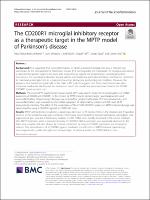| dc.contributor | Vall d'Hebron Barcelona Hospital Campus |
| dc.contributor.author | Serratosa, Joan |
| dc.contributor.author | Bove Badell, Jordi |
| dc.contributor.author | Vila Bover, Miquel |
| dc.contributor.author | Saura, Josep |
| dc.contributor.author | Solà, Carme |
| dc.contributor.author | Rabaneda-Lombarte, Neus |
| dc.date.accessioned | 2021-11-24T09:16:03Z |
| dc.date.available | 2021-11-24T09:16:03Z |
| dc.date.issued | 2021-04-06 |
| dc.identifier.citation | Rabaneda-Lombarte N, Serratosa J, Bové J, Vila M, Saura J, Solà C. The CD200R1 microglial inhibitory receptor as a therapeutic target in the MPTP model of Parkinson's disease. J Neuroinflammation. 2021 Apr 6;18:88. |
| dc.identifier.issn | 1742-2094 |
| dc.identifier.uri | https://hdl.handle.net/11351/6592 |
| dc.description | Microglia; Neuroinflammation; Parkinson’s disease |
| dc.description.abstract | Background
It is suggested that neuroinflammation, in which activated microglial cells play a relevant role, contributes to the development of Parkinson’s disease (PD). Consequently, the modulation of microglial activation is a potential therapeutic target to be taken into account to act against the dopaminergic neurodegeneration occurring in this neurological disorder. Several soluble and membrane-associated inhibitory mechanisms contribute to maintaining microglial cells in a quiescent/surveillant phenotype in physiological conditions. However, the presence of activated microglial cells in the brain in PD patients suggests that these mechanisms have been somehow overloaded. We focused our interest on one of the membrane-associated mechanisms, the CD200-CD200R1 ligand-receptor pair.
Methods
The acute MPTP experimental mouse model of PD was used to study the temporal pattern of mRNA expression of CD200 and CD200R1 in the context of MPTP-induced dopaminergic neurodegeneration and neuroinflammation. Dopaminergic damage was assessed by tyrosine hydroxylase (TH) immunoreactivity, and neuroinflammation was evaluated by the mRNA expression of inflammatory markers and IBA1 and GFAP immunohistochemistry. The effect of the modulation of the CD200-CD200R1 system on MPTP-induced damage was determined by using a CD200R1 agonist or CD200 KO mice.
Results
MPTP administration resulted in a progressive decrease in TH-positive fibres in the striatum and TH-positive neurons in the substantia nigra pars compacta, which were accompanied by transient astrogliosis, microgliosis and expression of pro- and anti-inflammatory markers. CD200 mRNA levels rapidly decreased in the ventral midbrain after MPTP treatment, while a transient decrease of CD200R1 mRNA expression was repeatedly observed in this brain area at earlier and later phases. By contrast, a transient increase in CD200R1 expression was observed in striatum. The administration of a CD200R1 agonist resulted in the inhibition of MPTP-induced dopaminergic neurodegeneration, while microglial cells showed signs of earlier activation in CD200-deficient mice.
Conclusions
Collectively, these findings provide evidence for a correlation between CD200-CD200R1 alterations, glial activation and neuronal loss. CD200R1 stimulation reduces MPTP-induced loss of dopaminergic neurons, and CD200 deficiency results in earlier microglial activation, suggesting that the potentiation of CD200R1 signalling is a possible approach to controlling neuroinflammation and neuronal death in PD. |
| dc.language.iso | eng |
| dc.publisher | BMC |
| dc.relation.ispartofseries | Journal of Neuroinflammation;18 |
| dc.rights | Attribution 4.0 International |
| dc.rights.uri | http://creativecommons.org/licenses/by/4.0/ |
| dc.source | Scientia |
| dc.subject | Parkinson, Malaltia de - Tractament |
| dc.subject | Micròglia - Efecte dels medicaments |
| dc.subject.mesh | Microglia |
| dc.subject.mesh | /drug effects |
| dc.subject.mesh | Parkinson Disease |
| dc.subject.mesh | /drug therapy |
| dc.title | The CD200R1 microglial inhibitory receptor as a therapeutic target in the MPTP model of Parkinson’s disease |
| dc.type | info:eu-repo/semantics/article |
| dc.identifier.doi | 10.1186/s12974-021-02132-z |
| dc.subject.decs | microglía |
| dc.subject.decs | /efectos de los fármacos |
| dc.subject.decs | enfermedad de Parkinson |
| dc.subject.decs | /farmacoterapia |
| dc.relation.publishversion | https://doi.org/10.1186/s12974-021-02132-z |
| dc.type.version | info:eu-repo/semantics/publishedVersion |
| dc.audience | Professionals |
| dc.contributor.organismes | Institut Català de la Salut |
| dc.contributor.authoraffiliation | [Rabaneda-Lombarte N] Department of Cerebral Ischemia and Neurodegeneration, Institut d’Investigacions Biomèdiques de Barcelona-Consejo Superior de Investigaciones Científicas (CSIC), Institut d’Investigacions Biomèdiques August-Pi i Sunyer (IDIBAPS), Barcelona, Spain. Biochemistry and Molecular Biology Unit, School of Medicine, University of Barcelona, IDIBAPS, Barcelona, Spain. [Serratosa J, Solà C] Department of Cerebral Ischemia and Neurodegeneration, Institut d’Investigacions Biomèdiques de Barcelona-Consejo Superior de Investigaciones Científicas (CSIC), Institut d’Investigacions Biomèdiques August-Pi i Sunyer (IDIBAPS), Barcelona, Spain. [Bové J] Vall d’Hebron Institut de Recerca (VHIR), Barcelona, Spain. CIBERNED, Barcelona, Spain. [Vila M] Vall d’Hebron Institut de Recerca (VHIR), Barcelona, Spain. CIBERNED, Barcelona, Spain. Catalan Institution for Research and Advanced Studies (ICREA), Barcelona, Spain. [Saura J] Biochemistry and Molecular Biology Unit, School of Medicine, University of Barcelona, IDIBAPS, Barcelona, Spain |
| dc.identifier.pmid | 33823877 |
| dc.identifier.wos | 000637502400001 |
| dc.relation.projectid | info:eu-repo/grantAgreement/ES/PE2013-2016/PI15%2F00033 |
| dc.relation.projectid | info:eu-repo/grantAgreement/ES/PE2013-2016/FPU13%2F05491 |
| dc.rights.accessrights | info:eu-repo/semantics/openAccess |

